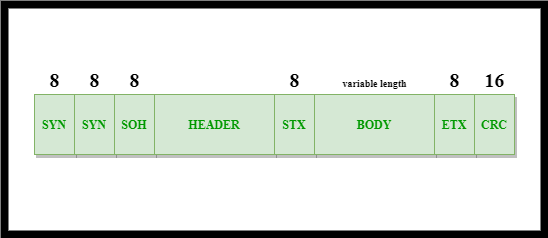Frame Format of BISYNC
Last Updated :
26 Aug, 2020
Binary Synchronous Communication Protocol (BISYNC) is a byte oriented communication protocol and a data link layer protocol, developed by IBM. In a byte oriented approach, every frame is viewed as a set of bytes/characters.
Some of the favored byte oriented protocols are –
- BISYNC (Binary synchronous communications protocol)
- Point to point protocol (PPP)
- DDCMP (Digital data communications message protocol)
BISYNC is also referred as BSC. BISYNC follows a sentinel approach. A sentinel approach is a guarding kind of behavior, exhibited by certain fields in frame format.
Frame Format of BISYNC :

- BISYNC has two (BI) synchronous fields (SYNC) in the starting of the frame.
- The frame format includes two synchronous fields of 8 bits each. These two fields are essential to spot the beginning of the frame.
- The third field is SOH (start of header) which of 8 bits, followed by fourth field – header.
- The fifth field is STX (start of text) which of 8 bits, followed by a body, of variable length.
- The body, is followed by ETX (end of text) which of 8 bits.
- CRC (cyclic redundancy check) is the last field of 16 bits, which is required for error detection.
- Frames are transmitted, beginning with leftmost field.
- The start of the frame is denoted by sending a special SYN (synchronize) character.
- Data portion of the frame, is contained between special sentinel character STX and ETX i.e., the body is guarded by STX & ETX.
STX and ETX :
- If the receiver encounters STX or ETX inside the body, it misunderstands them to be the actual STX or ETX.
- This problem, can be handled, using byte/character stuffing approach.
Note –
We use byte/character stuffing approach here, since it is a byte oriented protocol which employs character oriented approach. We use bit stuffing approach, in a bit oriented protocol.
- Byte/character stuffing approach can be defined as a process of adding one extra byte whenever there’s a flag or escape character within the text.
- A flag/escape character, say SYN/STX/ETX if found repeated twice in the body, an additional one byte will be added.
- This process of byte/character stuffing is handled by DLE (Data link escape) in BISYNC protocol. A DLE is a character used to carry non-printable characters in frame.
Like Article
Suggest improvement
Share your thoughts in the comments
Please Login to comment...